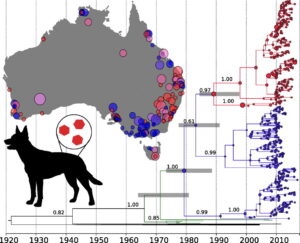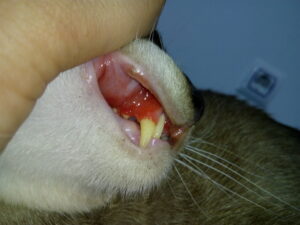It’s essential to understand about the specific health risks that your companion may face. Among the most concerning and easy to prevent are viral infections, which can have severe consequences if not addressed promptly. In this comprehensive guide, we’ll delve into the infections that can be prevented through vaccination,with a special focus on their prevalence and impact in Australia. Understanding the nature of these infections, their symptoms, transmission, and prevention measures will empower you to take proactive steps in safeguarding your pet’’s health.
Canine Parvovirus in Australia
Canine Parvovirus, commonly known as Parvo, is a highly contagious and potentially fatal virus that has been a concern in Australia for many years.
Epidemiology:
 Prevalence: Parvovirus continues to be a significant threat in Australia, particularly in densely populated urban areas or regional areas where herd immunity is low due to poor vaccination rates. It is more prevalent in certain regions with higher dog populations and can fluctuate from year to year.
Prevalence: Parvovirus continues to be a significant threat in Australia, particularly in densely populated urban areas or regional areas where herd immunity is low due to poor vaccination rates. It is more prevalent in certain regions with higher dog populations and can fluctuate from year to year.
- Seasonal Variations: Parvovirus tends to be more active during warmer months, with peaks in cases typically occurring in spring and summer.
- Age Susceptibility: Puppies and young dogs are most susceptible to Parvovirus. The virus is particularly dangerous for puppies that have not yet completed their full vaccination series.
- Environmental contamination: Parvovirus can survive in the environment for many years, especially in organic matter, like soil and grass. However the virus is susceptible to household bleach.
Disease:
A dog usually gets infected with parvovirus orally when directly sniffing or licking contaminated areas, but the virus can also be brought to them when it is spread through objects, hands, shoes from a contaminated space to the house.
There is an incubation period of 3 to 7 days after exposure to the virus. When swallowed, the virus infected the lymph nodes on the throat or tonsils. From there they will reach rapid multiplying tissue, like the intestinal walls, but also the heart and bone marrow.
Parvovirus causes the destruction of the intestinal lining and villous atrophy, resulting in severe gastroenteritis, haemorrhagic diarrhoea, vomiting, dehydration, lethargy, anaemia and fever.
In young puppies the disease can cause death in the early stages of it. Adults dogs are more likely to recover.
Canine Distemper in Australia
Canine Distemper, caused by the Canine Distemper Virus (CDV), is another significant viral threat in Australia.
Epidemiology:
- Historical Impact: Due to successful vaccination campaigns, Distemper has become less common in Australia in recent years. However, isolated outbreaks can still occur, particularly in areas with lower vaccination rates.
- Wildlife Reservoir: In some regions, especially those with a high population of wildlife, the virus can persist in wild animals (foxes, dingoes, ferrets , posing a continuous risk to domestic dogs.
- People movement: In recent years, travelling within Australia has become more popular and people are constantly moving interstate, from regional areas to the city and vice versa. This makes it more difficult to control the virus to certain areas.
- Contamination: Distemper is easily eliminated from the environment with most disinfectants, however it can be shed by a dog for several months.
Disease:
Distemper transmission usually happens via airborne exposure, like sneezing and coughing from an infected dog. However the virus can also be eliminated in the faeces, contaminating objects and the environment. The virus can also pass through the placenta, transmitting the disease to the puppies.
The virus infects multiple parts of the body, including the respiratory system (lungs), eyes, bladder, skin, gastrointestinal tract, brain and spinal chord. Therefore the symptoms are very broad: fever, clear nasal discharge, purulent eyes, lethargy, anorexia, coughing, vomiting, diarrhoea, dermatitis and seizures.
Unfortunately, recovery from Distemper is difficult and most dogs are left with sequelae from the neurological signs.
Canine Hepatitis in Australia
Canine Hepatitis, caused by Canine Adenovirus Type 1 (CAV-1), is a less common but still significant viral threat in Australia.
Epidemiology:
- Prevalence: Canine Hepatitis is relatively rare in well-vaccinated populations. However, isolated cases or outbreaks can occur, particularly in areas with lower vaccination rates.
- Reservoir: Similar to Distemper, wild animals can serve as a reservoir for Canine Hepatitis.
Disease:
The infection occurs via oronasal (inhalation or ingestion) exposure of contaminated urine, faeces or saliva from infected dogs. After entering the body the virus lives in tiny blood vessels but also inside the liver, kidneys, spleen and lungs.
Common signs of Hepatitis are lethargy, conjunctivitis, eyes discharge, abdominal pain, vomiting and bleeding due to reduced clotting. Puppies are very ill and many may not survive the infection.
Feline Panleukopenia in Australia
Feline Panleukopenia, commonly known as Feline Distemper, is a highly contagious and potentially fatal virus that has been a concern in Australia for many years.
Epidemiology:
- Prevalence: While successful vaccination campaigns have reduced the incidence of Feline Panleukopenia, sporadic cases still occur in Australia. It is more common in areas with higher cat populations and can occasionally experience outbreaks.
- Age Susceptibility: Kittens and young cats are most susceptible to Feline Panleukopenia. The virus is particularly dangerous for kittens that have not yet completed their full vaccination series.
Disease:

Feline Panleukopenia virus causes a severe infection in multiple tissues similar to Parvovirus, such as bone marrow, intestines and foetus. Kittens can quickly deteriorate and become severely anaemic. The most common symptoms are fever, lethargy, vomiting, diarrhoea and abdominal pain.
Feline Herpesvirus
Feline Herpesvirus, also known as Feline Rhinotracheitis, is caused by the Feline Herpesvirus Type 1 (FHV-1) and is a significant viral threat in Australia.
Epidemiology:
- Prevalence: Feline Herpesvirus is widespread in Australia’s cat population. It is highly contagious and can be found in both urban and rural areas.
- Chronic Carriers: Cats that have recovered from the initial infection can become lifelong carriers, periodically shedding the virus and potentially infecting other cats.
Disease:

Feline Herpesvirus is one of the most common causes of upper respiratory airway disease in cats and there is no cure. Cats normally present with an inflammation of the tissues around the eyes and nose, causing sneezing, nasal congestion, conjunctivitis, squinting, low appetite etc.
The symptoms can be alleviated and the condition resolved, but the virus stays latent in the cat and can be reactivated at any time in their lives (often during stressful periods). Infected cats also shed the virus and can easily infected other cats that get in contact with them.
Feline Calicivirus in Australia
Feline Calicivirus is another prevalent respiratory virus in Australia’s feline population.
Epidemiology:
- Prevalence: Feline Calicivirus is widespread and highly contagious. It can cause outbreaks in environments with close cat interactions, such as shelters or multi-cat households.
- Mutation Rate: Feline Calicivirus has a high mutation rate, leading to the emergence of new strains. This can sometimes complicate vaccination efforts.
Disease:

Calicivirus also causes upper respiratory disease in cats as well as inflammatory oral ulcers. The most common signs are sneezing, nasal congestion, ulcers on the tongue, hard palate, gums, lips and/or nose. Some cats salivate or drool excessively because of the pain caused by the ulcers.
What’s next..
In our next post, we’ll discuss our clinic’s vaccination protocols for cats and dogs.